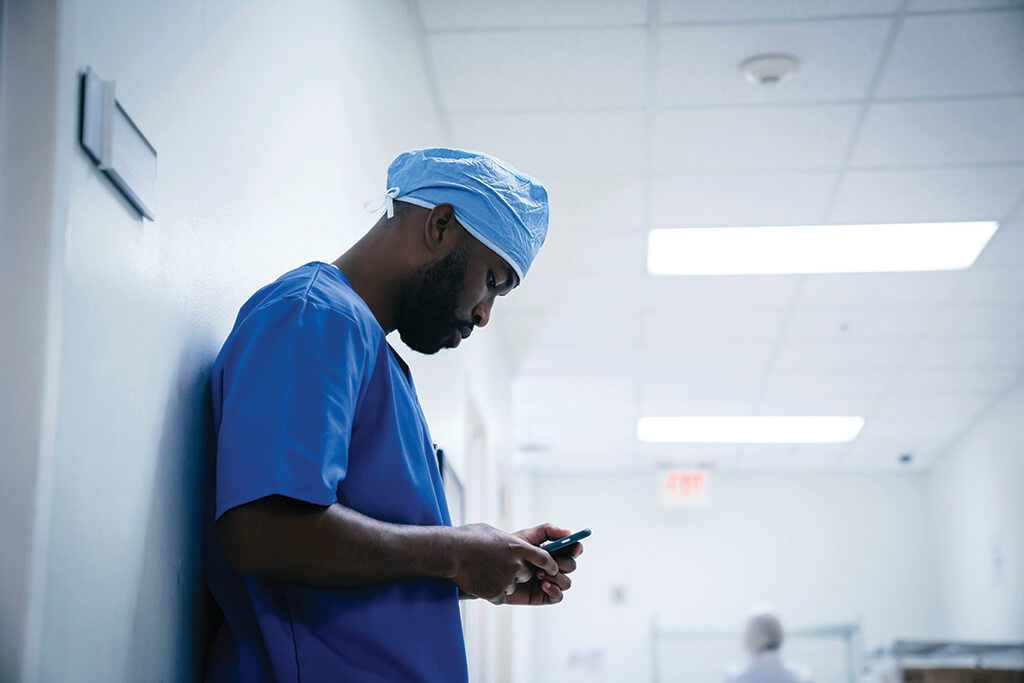

It’s never been easy to get through to hospitalists, the in-house physicians who oversee care for hospitalized patients. But as COVID-19 cases surge anew, these specialists find themselves swamped, intensifying the communication challenges — and competition — for drug and device companies eager to reach them.
Truly engaging with this population of 62,000 exhausted professionals was hard prior to the pandemic; now it ranks as the medical marketing equivalent of Mission: Impossible. So it goes without saying that the old playbook needs to be replaced with a new one that is sensitive to hospitalists’ current struggles and attuned to their unique information needs.
“Even before the pandemic, they were a difficult audience to engage,” says George Musi, managing director of Solve(d). The problem, he notes, is that reaching hospitalists at the ideal moment — when they’re researching medications or ordering a test or procedure — is often logistically daunting: “When they are working in the hospital, their devices are generally shut off.”
COVID-19 has made that magic moment even more distant, rewriting the rules about connecting with providers. “After their shift, hospitalists are just so exhausted that their ability to register anything becomes less and less. Physically, mentally, emotionally — they’re just spent,” Musi adds.
But when he connects with colleagues in other hospitals, Garneau sees how enormous and pervasive the problems truly are. “Hospitalists are stretched thin, with nurses and other support staff leaving. Many of my friends are just exhausted and frustrated that they’re all going through more of this,” he says.
The first step to more effectively marketing to hospitalists is understanding what makes them so different. The world of life-sciences marketing is accustomed to tracking providers down by disease states or sub-specialties.
Hospitalists, on the other hand, are defined by their location: the hospital. As a result, their job is to treat and communicate with patients about a much wider variety of health conditions. While the same may be true for primary care physicians, hospitalists often function in the higher-pressure realms of emergency departments and intensive care units.
Since the subspecialty first emerged in 1996, it has become the fastest-growing one in the medical profession, the American Medical Association reports. The Society of Hospital Medicine (SHM) says that while most of its members are physicians who are internists, the membership rolls include a growing number of nurse practitioners and physician assistants.
Often, members move into higher-level administrative roles in hospitals and hospital systems. The SHM says hospitalists have been shown to reduce the length of patient stays by up to 30% and reduce hospital costs by up to 20%. Demographically, they tend to be younger than other specialists, which has implications for digital preferences.
A recent Medscape report notes that more than half are between 35 and 49 years old and nearly three-quarters are 50 or younger. By comparison, only about half of non-hospitalist physicians are 50 or younger. Hospitalists also spend more time with patients than non-hospitalists: 42 hours per week versus 37, Medscape notes. They’re tasked with more busy work: 23 hours per week on paperwork and administrative tasks, versus 16 for non-hospitalists.
Perhaps as a result of all this, the American Medical Association believes hospitalists are especially vulnerable to burnout. “With COVID-19, these hospitalists face even more stress because of the sheer number of patients who are testing positive and [requiring] hospital care,” the organization noted in a September 2020 blog post.
A newer study, published in the Journal of Hospital Medicine, found that while burnout among hospitalists is still high, it may be below previously reported levels.
“Overall job satisfaction was high, with very few respondents having considered leaving their job or looking for alternative employment,” researchers found after studying several hospitals in Oregon. “Hospitalists did perceive, in descending order, significant health risks to their families, themselves, their colleagues and their patients. Practitioners reported that the pandemic affected their healthcare organization more than it affected themselves.”
About 35.6% said they experienced “high emotional exhaustion or depersonalization.” Hopkins’ Garneau believes this can lead to “worsening quality of care and standards, because you don’t have the same cohesion.”
The problem: That potentially applies to all illnesses, not just COVID-19.

“The pandemic has caused mass disruption in the diagnosis and treatment of serious conditions such as cardiovascular disease (CVD), creating and exacerbating chronic-disease pandemics,” says Victor Bulto, head of U.S. pharmaceuticals at Novartis.
The company is in the midst of launching Leqvio, the first siRNA therapy to lower LDL-C. Its marketing approach, targeting 200 systems of care that manage a large share of Americans with atherosclerotic cardiovascular disease, doesn’t involve hospitalists because the injectable drug is administered at doctors’ offices.
But the COVID-19 crisis within hospitals still impacts Novartis’ marketing plan, since hospitalists play such an outsized role in treating patients with heart disease.
“Studies suggest that the COVID-19 pandemic has led to worsening outcomes for patients with CVD in the U.S.,” Bulto says, emphasizing that flexibility is critical as variants surge. “We are closely monitoring the situation and ready to deploy different communication strategies as necessary.”
For COVID-era hospitalists, then, the separation between personal and professional life has blurred. As a result, they’re unlikely to take any rep meetings, even virtual ones. And they don’t want to be sold, Musi says. “What they do want are ways out, removing themselves from the crush of the day’s work so they can focus on themselves and get prepared for the next day’s work.”
That requires a deeper understanding, typically through the curation of in-depth profile and persona definitions, in order to help marketers shift from merely reaching these specialists to truly addressing their concerns. “It means finding them at a point where we can have an opportunity to have a conversation with them,” Musi adds.
In addition to detailed personal and archetype studies, geospatial analysis is a necessary ingredient in any hospitalist plan. “We know where they’re located and can find them down to a ZIP-plus-4 level, which is really granular. We also know where they work, so we have a multidimensional way to triangulate,” he says, adding that search can offer valuable clues: “If you follow that person long enough, you understand what they’re aiming to do. You get a pattern of behavior over weeks, so you know the most opportune time to engage.”
And then there’s native content, ideally in the form of micro-communications that are easily digested in the 10 to 15 minutes before the start of a shift or during breaks.
That thinking lines up the way hospitalists such as Garneau — a Twitter devotee — seek out news and information. “I read what people are posting, so I get lots of updates there. And I follow what’s happening through the Society of Hospital Medicine.”
While Garneau maintains print subscriptions to medical journals, he doesn’t read them as much as he once did. At the start of his workday, he talks to night doctors about patients, reads through notes at his desk and checks on data points that might prove critical during the hours ahead. But once he starts seeing patients, he’s immersed in their care and off the digital grid for two to three hours at a time.
Some days, Garneau oversees residents. Occasionally, there’s enough spare time to check back in with Twitter, check email or read up on a topic that arose during his shift. “But other days, it’s just me,” he says.
Pointing to habits and routines such as these, Musi stresses that mobile formats — notably short videos that pop on larger-screen smartphones — are essential for reaching hospitalists. While 15 seconds is the ideal length for these video bursts, they need to be part of a larger story or series.
“It has to feel native so that it fits in with what they are watching on, let’s say, YouTube,” he explains.
Indeed, targeting hospitalists requires deeper thinking about time-of-day and day-of-week considerations than marketers are used to — which is why Musi and his colleagues will attempt to reach them outside the hospital walls. But such approaches come with their share of risk as well: Pharma ads might fit nicely into a particular genre of music streamed after a hospitalist’s workday is done, but they could also be perceived as unnecessarily intrusive.
“Hospitalists probably watch plenty of goofy videos on TikTok to decompress, or maybe they Snap with their friends. But a message about a new drug wouldn’t feel native there,” Musi says.
Garneau agrees. He empathizes with pharma’s desire to more effectively connect with him in the digital realm, but doesn’t want to be bothered when he’s taking care of himself — when he’s at the gym, for instance, or using the Headspace app for meditation.
“Ads just aren’t welcome there,” he says. “That’s my time. I don’t want to be sold something.”
more recommended stories
 Safer Allogeneic Stem Cell Transplants with Treg Therapy
Safer Allogeneic Stem Cell Transplants with Treg TherapyA new preclinical study from the.
 Autoimmune Disorders: ADA2 as a Therapeutic Target
Autoimmune Disorders: ADA2 as a Therapeutic TargetAdenosine deaminase 2 (ADA2) has emerged.
 Kaempferol: A Breakthrough in Allergy Management
Kaempferol: A Breakthrough in Allergy ManagementKaempferol, a dietary flavonoid found in.
 Early Milk Cereal Drinks May Spur Infant Weight Gain
Early Milk Cereal Drinks May Spur Infant Weight GainNew research published in Acta Paediatrica.
 TaVNS: A Breakthrough for Chronic Insomnia Treatment
TaVNS: A Breakthrough for Chronic Insomnia TreatmentA recent study conducted by the.
 First-of-Its-Kind Gene-Edited Pig Kidney: Towana’s New Life
First-of-Its-Kind Gene-Edited Pig Kidney: Towana’s New LifeSurgeons at NYU Langone Health have.
 Just-in-Time Training Improves Success & Patient Safety
Just-in-Time Training Improves Success & Patient SafetyA study published in The BMJ.
 ChatGPT Excels in Medical Summaries, Lacks Field-Specific Relevance
ChatGPT Excels in Medical Summaries, Lacks Field-Specific RelevanceIn a recent study published in.
 Study finds automated decision minimizes high-risk medicine combinations in ICU patients
Study finds automated decision minimizes high-risk medicine combinations in ICU patientsA multicenter study coordinated by Amsterdam.
 Study Discovers Connection Between Omicron Infection and Brain Structure Changes in Men
Study Discovers Connection Between Omicron Infection and Brain Structure Changes in MenA recent study in the JAMA.

Leave a Comment